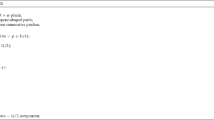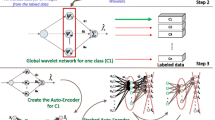Abstract
In this paper, we propose a feature detector for the neural network. Our feature detector aims to decompose input patterns into minimum constituents or atomic features. Atomic features are classified into features, common to all the input patterns and features, specific to each pattern. Thus, our feature detector is mainly composed of a common feature detector, distinctive feature detectors. The other two components are an information maximizer and an error minimizer. The distinctive feature detector is realized by the information maximizer, which increases the information, specific to each pattern as much as possible. The error minimizer is a device to minimize the difference between targets and outputs, that is, a usual neural network. We applied our feature detector to two problems: detection of vertical and horizontal bars and the phonological feature detection. In both cases, experimental results confirmed that distinctive features could clearly be extracted and that the common feature detector could extract features, as close as possible to the common features.
Similar content being viewed by others
Explore related subjects
Discover the latest articles, news and stories from top researchers in related subjects.References
R. P. Gorman, T. J. Sejnowski. Analysis of hidden units in a layered network trained to classify sonar targets,Neural Networks, vol.1, pp.75–89, 1988.
Y. LeCun, B. Boser, J.S. Denker, D. Henderson, R. E. Howard, W. Hubbard, L. D. Jackel. Backprogagation applied to handwritten Zip code recognition,Neural Computation, vol. 1, pp. 541–551, 1989.
D. E. Rumelhart, G. E. Hinton, R. J. Williams. Learning internal representation by error propagation, inParallel Distributed Processing, D. E. Rumelhart, J. L. McClelland, and the PDP Research Group, Cambridge, Massachusetts: the MIT Press, vol. 1, pp. 318–362, 1986.
M. Ishikawa, Y. Yamamoto. Discovery of rules and generalization by structural learning of neural networks,The Brain and Neural Networks, vol. 1, no. 2, pp. 57–63, 1994.
G. Deco, W. Finnof, H. G. Zimmermann. Elimination of overtraining by a mutual information network, inProceeding of the International Conference on Artificial Neural Networks, Springer-Verlag, pp. 744–749, 1993.
R. Kamimura and S. Nakanishi.Kernel hidden unit analysis, IEICE Transaction on Information and Systems, vol. E78-D, no. 4, pp. 484–489, 1995.
M. C. Mozer, P. Smolensky. Using relevance to reduce network size automatically,Connection Science, vol. 1, no. 1, pp. 3–16, 1989.
Author information
Authors and Affiliations
Rights and permissions
About this article
Cite this article
Kamimura, R., Nakanishi, S. Feature detectors by autoencoders: Decomposition of input patterns into atomic features by neural networks. Neural Process Lett 2, 17–22 (1995). https://doi.org/10.1007/BF02309011
Issue Date:
DOI: https://doi.org/10.1007/BF02309011




